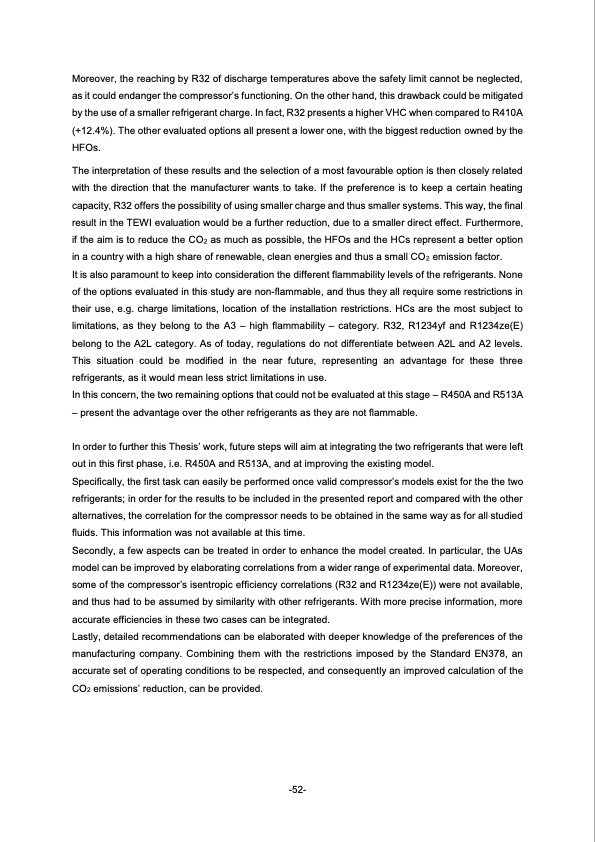
PDF Publication Title:
Text from PDF Page: 061
Moreover, the reaching by R32 of discharge temperatures above the safety limit cannot be neglected, as it could endanger the compressor’s functioning. On the other hand, this drawback could be mitigated by the use of a smaller refrigerant charge. In fact, R32 presents a higher VHC when compared to R410A (+12.4%). The other evaluated options all present a lower one, with the biggest reduction owned by the HFOs. The interpretation of these results and the selection of a most favourable option is then closely related with the direction that the manufacturer wants to take. If the preference is to keep a certain heating capacity, R32 offers the possibility of using smaller charge and thus smaller systems. This way, the final result in the TEWI evaluation would be a further reduction, due to a smaller direct effect. Furthermore, if the aim is to reduce the CO2 as much as possible, the HFOs and the HCs represent a better option in a country with a high share of renewable, clean energies and thus a small CO2 emission factor. It is also paramount to keep into consideration the different flammability levels of the refrigerants. None of the options evaluated in this study are non-flammable, and thus they all require some restrictions in their use, e.g. charge limitations, location of the installation restrictions. HCs are the most subject to limitations, as they belong to the A3 – high flammability – category. R32, R1234yf and R1234ze(E) belong to the A2L category. As of today, regulations do not differentiate between A2L and A2 levels. This situation could be modified in the near future, representing an advantage for these three refrigerants, as it would mean less strict limitations in use. In this concern, the two remaining options that could not be evaluated at this stage – R450A and R513A – present the advantage over the other refrigerants as they are not flammable. In order to further this Thesis’ work, future steps will aim at integrating the two refrigerants that were left out in this first phase, i.e. R450A and R513A, and at improving the existing model. Specifically, the first task can easily be performed once valid compressor’s models exist for the the two refrigerants; in order for the results to be included in the presented report and compared with the other alternatives, the correlation for the compressor needs to be obtained in the same way as for all studied fluids. This information was not available at this time. Secondly, a few aspects can be treated in order to enhance the model created. In particular, the UAs model can be improved by elaborating correlations from a wider range of experimental data. Moreover, some of the compressor’s isentropic efficiency correlations (R32 and R1234ze(E)) were not available, and thus had to be assumed by similarity with other refrigerants. With more precise information, more accurate efficiencies in these two cases can be integrated. Lastly, detailed recommendations can be elaborated with deeper knowledge of the preferences of the manufacturing company. Combining them with the restrictions imposed by the Standard EN378, an accurate set of operating conditions to be respected, and consequently an improved calculation of the CO2 emissions’ reduction, can be provided. -52-PDF Image | Next generation of refrigerants for residential heat pump systems

PDF Search Title:
Next generation of refrigerants for residential heat pump systemsOriginal File Name Searched:
MartinaLonghini_ThesisReport.pdfDIY PDF Search: Google It | Yahoo | Bing
CO2 Organic Rankine Cycle Experimenter Platform The supercritical CO2 phase change system is both a heat pump and organic rankine cycle which can be used for those purposes and as a supercritical extractor for advanced subcritical and supercritical extraction technology. Uses include producing nanoparticles, precious metal CO2 extraction, lithium battery recycling, and other applications... More Info
Heat Pumps CO2 ORC Heat Pump System Platform More Info
| CONTACT TEL: 608-238-6001 Email: greg@infinityturbine.com | RSS | AMP |